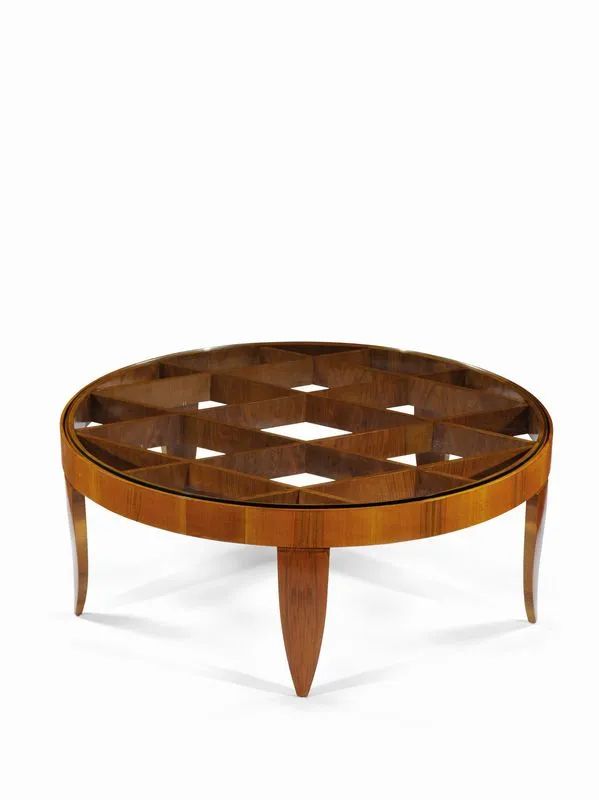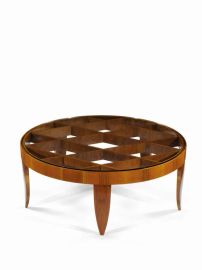Gio Ponti
(Milan 1891-1972)
COFFEE TABLE, 1937
Chestnut briar root and crystal
Made by Giordano Chiesa
Height 40 cm diameter 108 cm
This piece is accompanied by an certificate of expertise issued by Gio Ponti Archives and dated September 7th 2016
Provenienza
Gio Ponti. Una Collezione, Sotheby’s, Milano 18 aprile 2005, lotto 48;
Milano, Collezione privata
A key figure in Italian design, Gio Ponti is the main author of the renewal of Italian decorative arts in the 1920 and ‘30s. During a time of great stylistic uncertainty, he took up the call for a return to classic design which was winding around Europe at the time, but coupled it with an openness towards experimenting with new materials. He dedicated his inexhaustible creativity both to architectural design and to the creation of objects and furnishings. He soon became a reference point and example for his contemporaries.
His designs remained for the most part faithful to the principles of comfort and elegance, but constantly proposed new shapes – reticulates, grids, scalloping – which now mark out his era and are thoroughly imitated by today’s production.
In the mid-1930s, Ponti projected a small table characterized by an intricate grid, for the furnishing of only a select few residential commissions. The shape of the table, elegant and complex, gives an idea of solidity, but at the same time the combination of empty and solid spaces gives the table a relative lightness, an impression underlined and in some way strengthened by the crystal surface. While the grid motif, which often recurred in various forms throughout his work from the thirties to the fifties, represents an invention by Ponti, the detail of the tapered leg clearly echoes the neoclassical inspiration that dominated his designs between the end on the 1920s and the beginning of the ‘30s.
But proof of his artistry lies also in how he managed to elegantly intertwine traditional materials, such as the beautiful chestnut briar roots, with modern and refined resources such as crystal.
We know that in those years Ponti placed variants of this table in a number of different commissions, including the residence of the Cantoni family in Mantua (1935), Casa La Porte (1935) and Casa Borletti (1936) in Milan. Each time, however, he added small variations in scale and materials, thus always obtaining elegant new developments though remaining within the same style and classical inspiration.
LA CASA DI MODA
Tanti ci chiedono: dunque non si usa più l’arredamento “in antico”? Si usa l’arredamento moderno?
Se fossi un sarto per appartamenti io direi: Sì, a Parigi tutti fanno arredamenti moderni: i raffinati fanno degli interni meccanico-razionali arredati anche con mobili 1830, i raffinatissimi fanno camere tappezzate in pergamena, in “glauchat”, in paglia… Questo, Signore e Signori, è l’arredamento di moda per il 1928.
Ma io non sono un sarto, io sono un Architetto. Non è il moderno di moda che mi interessa, è stato di moda che mi interessa; è stato di moda anche il “liberty”, tutto è stato di moda e quelle che ci paion oggi le più brutte cose sono anch’esse state di moda: l’accedere ad una cosa attraverso la moda è la via più superficiale, irresponsabile, vile, indegna di noi.
Un’altra cosa vi chiedo o vi dico come Architetto: non fatevi la Casa secondo la moda ma secondo l’intelligenza e con un’amorosa cultura ed un nostrano buon senso.
La casa serve per la nostra vita materiale, deve avere tutti gli accorgimenti di costituzione e di funzionamento per essere utile, pratica, comoda, igienica, semplice a governarsi.
La casa accompagna la nostra vita, è il “vaso” delle nostre ore belle e brutte, è il tempo per i nostri pensieri più nobili, essa non deve essere di moda, perché non deve passare di moda.
Voluta, costituita, arredata con amorosa comprensione di queste sue funzioni materiali ed etiche, la nostra abitazione sarà la vera nostra casa, sarà la dignitosa dimora dell’Uomo e rappresenterà non le tracce di mode caduche e successive ma la testimonianza della nostra intelligenza, della nostra vita, della nostra cultura e della nobiltà delle cose che amiamo.
GIO PONTI, in “Domus”, Agosto 1928
Comparative literature
“In visita alle case”, Domus, maggio 1937 n. 113, p. 41 fig. 5;
U. La Pietra (a cura di), Gio Ponti, Milano 1995, p. 58 fig. 133; p. 61 fig. 139 (per esemplari simili);
F. Irace (a cura di), Gio Ponti, Milano 1997, p. 33 (esemplare analogo, citato come “tavolo per l’appartamento del signor B.”);
I. de Guttry, M.P. Maino, Il mobile déco italiano, Milano 2006, p. 221 fig. 37 (esemplare simile, fotografato nella casa di Ponti a Milano);
U. La Pietra, Gio Ponti. L'arte si innamora dell'industria, New York 2009, p. 61 fig. 139








